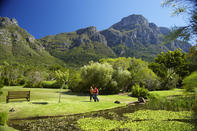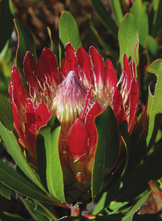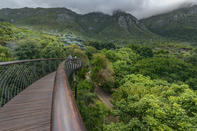Botanists in Raptures
Although the sandstone and granite edifice of Table Mountain, the Cape Peninsula and Cape Point are the great visual icons of the Cape of Good Hope, it is the vegetation that covers them that is its most significant natural feature.

What exactly is it about the Cape that has had botanists in raptures for centuries? To locals it is fynbos, from the Dutch "fynbosch" that describes the mostly hard, tough, leathery or spiky leaves that are environmental adaptations to prevent water loss in this harsh Mediterranean climate. To scientists it is the Cape Floristic Kingdom, covering less than half of one hundredth of Africa yet containing nearly 20 percent of the continent's flowering plants.
The numbers speak for themselves. The Cape Peninsula, just 407 square kilometres in extent, is home to around 2,500 different plant species. That is more than all of Great Britain, an area 5,000 times larger. The Cape Floral Kingdom is one of six floristic systems that cover the earth. Some span whole continents, others encircle the earth. And yet of these six; the tiny Cape Floral Kingdom is by far the richest by area.
Endemism

The only place that rivals the Cape Floral Kingdom in terms of concentration of species is the South American rainforest, with a mere third of the variety; In total there are some 9,000 plants in the fynbos region, of which 69 percent are endemic. The region has, for good reason, been called the world's hottest hot spot for plant diversity and endemism.
Not least because some 1,435 species are listed as threatened. Although the 82 species of proteas are best represented by the king and queen proteas, 'Protea cynaroides' and 'Protea magnifica', the richness of the system is better expressed by the heaths or ericas.
Kirstenbosch National Botanical Gardens

There are some 645 different species specific to the Cape; there are only 26 species in the rest of the world. When it comes to garden plants the Cape has provided far more than its fair share, best known being the pelargoniums, geraniums to gardeners, but also a whole basketful of flowering bulbs such as babiana, freesia, gladiolus, iris, moreae, sporaxis and watsonia as well as more than 1,000 species of the daisy family.
Numbers are all very well and impressive, but you need to walk in the fynbos, to smell the aromatic oils, see the multitude of flowers large and tiny, the butterflies, iridescent sunbirds and fur-ball mice that pollinate them. As good a place as any to start is Kirstenbosch National Botanical Gardens; this century-old garden of earthly delights was the first botanical garden in the world to be dedicated to indigenous plants and it is magnificent.
By David Bristow